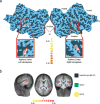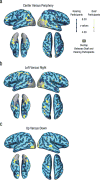Decoding Visual Location From Neural Patterns in the Auditory Cortex of the Congenitally Deaf
- PMID: 26423461
- PMCID: PMC5209787
- DOI: 10.1177/0956797615598970
Decoding Visual Location From Neural Patterns in the Auditory Cortex of the Congenitally Deaf
Abstract
Sensory cortices of individuals who are congenitally deprived of a sense can exhibit considerable plasticity and be recruited to process information from the senses that remain intact. Here, we explored whether the auditory cortex of congenitally deaf individuals represents visual field location of a stimulus-a dimension that is represented in early visual areas. We used functional MRI to measure neural activity in auditory and visual cortices of congenitally deaf and hearing humans while they observed stimuli typically used for mapping visual field preferences in visual cortex. We found that the location of a visual stimulus can be successfully decoded from the patterns of neural activity in auditory cortex of congenitally deaf but not hearing individuals. This is particularly true for locations within the horizontal plane and within peripheral vision. These data show that the representations stored within neuroplastically changed auditory cortex can align with dimensions that are typically represented in visual cortex.
Keywords: congenital deafness; decoding; fMRI; multivariate pattern analysis; neuroplasticity; sensory reorganization; visual location.
© The Author(s) 2015.
Conflict of interest statement
Declaration of Conflicting Interests The authors declared that they had no conflicts of interest with respect to their authorship or the publication of this article.
Figures




References
Publication types
MeSH terms
Grants and funding
LinkOut - more resources
Full Text Sources
Other Literature Sources
Medical

